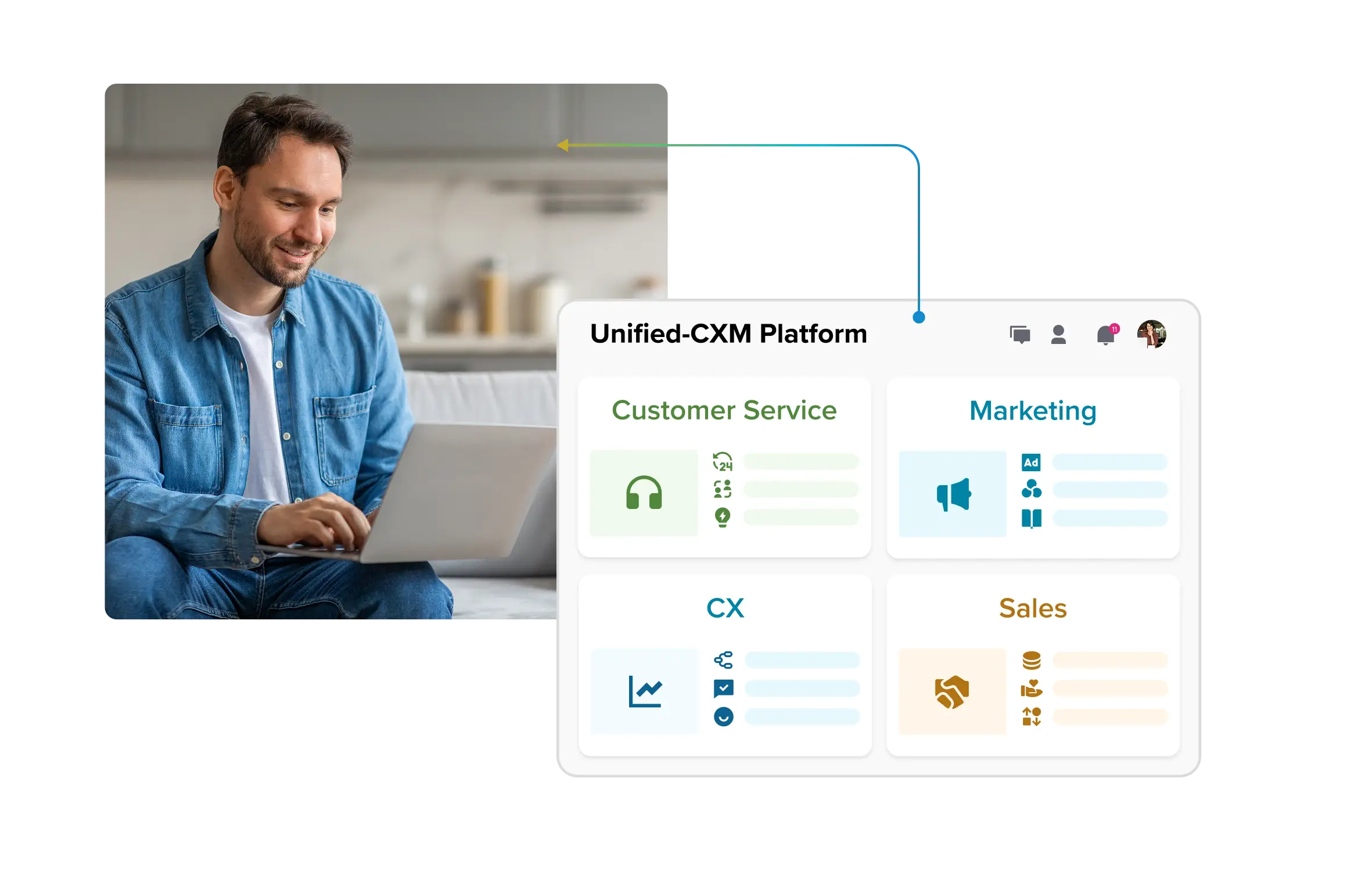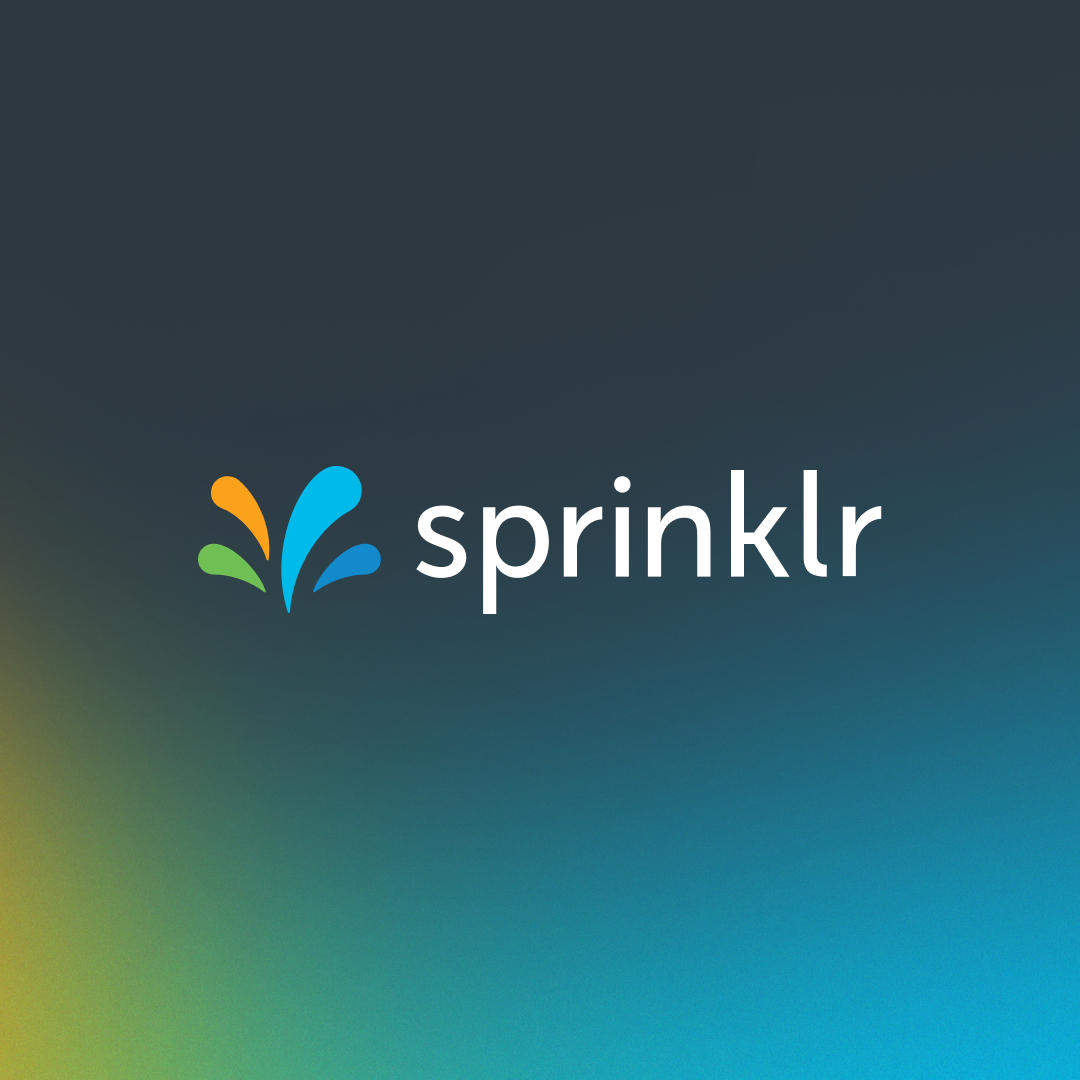The strategic AI-native platform for customer experience management
The strategic AI-native platform for customer experience management. Unify your customer-facing functions — from marketing and sales to customer experience and service — on a customizable, scalable, and fully extensible AI-native platform.

What is Customer Enablement: 5 Steps to Deploy Successfully
What is customer enablement?
Customer enablement is a strategic approach designed to empower customers with the knowledge, tools and resources they need to get the most value from your product or service.
Unlike traditional customer support, which tends to be reactive, customer enablement proactively equips users with guidance, self-service options and educational content that fosters confidence, independence and mastery over your product.
When implemented effectively, customer enablement minimizes customers’ reliance on support teams and maximizes the impact of each customer interaction on long-term satisfaction and loyalty.
Customer enablement is particularly critical in industries with complex or high-tech products, where product adoption and effective usage are essential to a company’s success. These industries include:
- SaaS and software development: Where customers need ongoing support and training to leverage dynamic software features.
- Telecommunications: To guide users in navigating advanced technology and service options.
- Financial services and fintech: To help customers utilize financial products effectively and securely.
- Healthcare and medical devices: Where user proficiency directly impacts patient care and compliance.
- Manufacturing and industrial equipment: Enabling customers to understand and operate sophisticated machinery easily.
In an enterprise setup, customer success teams, product management and development teams and customer service teams play critical roles in successfully driving customer enablement programs.
Customer enablement vs. sales enablement
While customer and sales enablement aims to support and empower, they each target different customer journey phases. Sales enablement equips sales teams with the tools and resources to effectively close deals. In contrast, customer enablement takes over post-sale, ensuring customers can maximize the value of the product or service they purchased.
Aspect | Customer enablement | Sales enablement |
Purpose | Empower customers post-purchase | Equip sales teams to close deals |
Focus | Customer success and satisfaction | Increasing conversion and deal closure rates |
Content & resources | Self-service resources, such as knowledge bases, FAQs, product guides and tutorials | Sales collateral, such as case studies, pitch decks, product comparisons and objection-handling guides. |
KPIs and metrics | Product usage rate, time-to-value, customer satisfaction (CSAT) and churn rate. | Win rate, average deal size, sales cycle length and quota attainment. |
Significance | Enhances long-term customer satisfaction, retention and advocacy, building loyalty and reducing support demand. | Drives initial revenue growth by increasing the effectiveness and efficiency of the sales team. |
How customer enablement differs from customer success
While customer enablement and customer success share a common goal — helping customers achieve the best possible outcomes with a product — they serve different functions and focus on unique aspects of the customer journey.
Customer enablement provides customers with the tools, resources and educational content to navigate the product independently.
On the other hand, customer success takes a more hands-on, relationship-driven approach to guide customers through their journey. Customer success teams work closely with customers, often in a proactive and personalized way, to ensure they are meeting their goals and realizing the product's full value. This involves frequent check-ins, onboarding support and regular communication to address specific needs, mitigate risks and foster long-term success.
📔 Related Read: Customer Relations: Top 5 Strategies and How to Implement Them
Benefits of customer enablement
When executed effectively, customer enablement delivers powerful advantages for both the customer and the business. Here’s a closer look at some key benefits:
📈 Increases customer satisfaction
Customer enablement programs are designed to keep customers informed, equipped and confident in using your product. By providing accessible resources and proactive support, these programs enhance the overall customer experience.
As customers become more comfortable with the product, they’re likely to have a positive experience and are also more inclined to recommend it to others. Satisfied customers directly result from well-executed enablement strategies, reflecting higher customer satisfaction scores and stronger brand loyalty.
🚀 Boosts product adoption rates
A strategic customer enablement approach accelerates product adoption by educating customers on features and capabilities that may go unnoticed. Customers can explore the product's full potential through webinars, FAQs, interactive guides or how-to videos, driving up usage and increasing their perceived value. This boosts adoption rates and shortens the time-to-value — a critical metric for any customer-centric business aiming for strong product engagement.
💵 Opens doors for upselling and cross-selling
As enablement strategies help customers gain proficiency with the primary offering, opportunities naturally arise to introduce advanced features or complementary products. Customers who understand the core product's value are more receptive to learning about premium add-ons, extensions or related offerings, creating organic upselling and cross-selling avenues that contribute directly to revenue growth.
📉 Reduces customer churn
Research from Gartner highlights that 60% of software buyers express regret over a purchase, with 24% canceling contracts and a third switching to another provider. Customer enablement can address this by reducing buyer’s remorse and preventing churn through timely, educational interventions that resolve customer pain points early. With ongoing support and frictionless guidance, customers are more likely to remain loyal and engaged, reducing churn and strengthening customer retention.
How to implement customer enablement strategies [+Tips]
Customer enablement involves a series of ongoing steps designed to support and empower users. Here's a break down of the process.
Step 1️⃣: Educate your customers
By helping customers understand how to use your products and services effectively and anticipating common challenges, you empower them to achieve value faster.
Providing access to a comprehensive knowledge base — complete with webinars, tutorials and product guides — complements the onboarding process and equips customers with the resources to troubleshoot and explore independently. This proactive approach builds customer confidence and enhances their sense of control and empowerment over their journey with your product.
Learn more about customer education.
💡Do you know
Modern knowledge base software can integrate conversational bots that engage directly with your content to provide quick, on-demand support. By leveraging AI-powered bots within your knowledge base, you can enable customers to resolve common queries without waiting for human assistance, reducing ticket backlog and improving response efficiency.
For instance, Sprinklr’s knowledge base software integrates seamlessly with conversational AI, offering intelligent, contextually relevant responses that help customers self-solve while lightening the load on support teams.

Step 2️⃣: Observe product adoption
Each customer’s learning curve is unique. While some customers may quickly become proficient with your product, others may require additional guidance, regardless of how intuitive the product is. Coaching account managers to recognize each customer’s level of proficiency early on is essential for delivering effective support and spotting those who may benefit from extra training.
For instance, if you offer a self-serve product, tracking how long each step typically takes for successful onboarding is crucial. If a customer spends significantly more time on a particular step, this may indicate a need for intervention. In such cases, a customer success manager should proactively check in, providing guidance and ensuring that customers stay on the fastest track to realizing value from their purchase.
By closely observing product adoption trends, you can make timely adjustments and provide personalized support that accelerates customers’ success and strengthens their engagement with your product.
Step 3️⃣: Create an online community
Building an online community connects new customers with experienced users who have discovered effective ways to use your products. Through these connections, customers can learn various use cases, explore hidden features and find customization options they might otherwise miss. This peer-to-peer exchange boosts product engagement and fosters a sense of belonging and shared purpose among users.
Not just enablement — co-innovate with customers
A thriving community is a powerful asset, providing invaluable insights into product gaps and evolving customer needs.
With Sprinklr’s community forum software, you don’t have to track these insights manually. Sprinklr AI empowers you to analyze every community conversation to uncover actionable insights into your products and services.
By automatically capturing feature requests, spotting emerging trends, and refining your product roadmap based on real-time feedback, you effortlessly stay aligned with industry shifts and customer expectations. Feedback fuels both product improvement and co-innovation, ensuring that your offerings continuously evolve to meet customer needs.

Step 4️⃣: Offer self-service resources
If you run a SaaS company offering a suite of digital marketing tools to a diverse range of business clients, consider the impact of constantly fielding simple, repetitive customer questions — issues that could easily be resolved through a quick search on a knowledge base.
To address this, a self-service portal could be a game-changer. By providing interactive tutorials, step-by-step guides and a searchable knowledge base organized around the user journey, you enable customers to find answers independently. With these resources at their fingertips, customers can troubleshoot, learn new features and explore advanced workflows without relying on direct support.
The value of self-service aligns well with modern customer expectations for on-demand assistance. Many users prefer resolving issues on their own, and offering a robust self-service option allows you to scale your support without stretching live assistance resources. When customers can quickly and effortlessly access the help they need, they feel more empowered and satisfied, which ultimately strengthens loyalty and encourages ongoing product adoption.
📌 Editor’s Pick: We were promised effective Self-Service. What went wrong, and what needs to change.
Step 5️⃣: Gather and act on feedback
Real-time feedback helps you identify gaps in the customer journey, uncover potential roadblocks and find opportunities to enhance your product’s usability.
For instance, let’s say you receive feedback that customers are struggling with a specific feature in your product suite. This insight gives you the chance to create targeted enablement resources—such as a how-to video, a detailed FAQ, or an interactive tutorial—that address that particular feature.
Additionally, incorporating a feedback loop through channels like in-app surveys or automated follow-up emails can ensure you capture consumer insights at every stage of the customer journey.
📋Compiled for You: Top 11 Customer Feedback Tools for Customer Service in 2025
3 Ways to integrate feedback into customer enablement strategies
Here are three effective ways to integrate customer feedback into your customer enablement strategy
1. Develop targeted learning content
Use customer feedback to identify areas where users need more guidance or find certain features challenging. With this information, you can create targeted learning resources like video tutorials, interactive guides, or knowledge-base articles that address specific customer pain points. Tailoring your content in response to feedback enhances customer confidence and helps them use your product more effectively.
2. Create a customer-driven product roadmap
Listening to recurring feedback on feature requests or usability improvements can help shape your product roadmap. A customer-driven approach to development demonstrates that you prioritize customer needs, which can, in turn, increase engagement and loyalty. When customers see their suggestions influence new features or enhancements, they are more likely to feel invested in your product and take full advantage of its capabilities.
3. Use AI to analyze feedback trends
Employing AI and sentiment analysis tools allows you to monitor feedback trends across multiple channels, such as social media, surveys, support tickets and community discussions. Analyzing these trends over time will enable you to identify recurring issues, emerging preferences and changing customer sentiments. This allows you to adjust your enablement resources proactively, ensuring your strategy stays aligned with your customer's evolving needs.
😊 Good to know
Sprinklr’s online survey software leverages Generative AI and verticalized AI models to provide direct, actionable insights with clear explanations of what happened and why. This powerful tool enables you to detect emerging customer experience drivers and uncover conversation themes with minimal setup, giving you the agility to adjust your strategy in real-time.


Case studies of successful customer enablement by businesses
Let’s examine how some of the most well-known brands successfully executed customer enablement.
Airbnb’s enhanced customer onboarding
Airbnb launched its app to improve the experience for new hosts unfamiliar with the platform. Many hosts needed help understanding how to navigate it, which led to slower onboarding times and hesitation in using the product's full capabilities.
To simplify onboarding with customer enablement resources, Airbnb created a detailed onboarding process that provided step-by-step tutorials, FAQ guides and access to community resources. They helped hosts feel more confident and comfortable.
This initiative resulted in faster onboarding times and increased host engagement, contributing to Airbnb’s overall success.
Microsoft’s customer education for Azure cloud services
Microsoft Azure recognized an incredible opportunity to empower enterprise customers to unlock the full potential of their cloud computing services. While many customers initially faced challenges navigating the platform's complex features, Microsoft took a proactive approach by developing a structured enablement plan to drive understanding and engagement.
In response, Microsoft launched dynamic learning paths and enticing certification programs designed specifically for Azure users. These initiatives educate customers and inspire them to embrace the platform's extensive capabilities fully. As a result, this visionary approach has led to a remarkable increase in Azure usage rates, fostering high customer satisfaction and loyalty.
Ceros’ sales enablement for design tools
Ceros, an innovative interactive design platform, identified a key challenge in helping new users fully understand and leverage the software's capabilities. Despite a steep initial learning curve, the team recognized an opportunity to enhance the user experience and build stronger customer relationships.
To address this, Ceros introduced a personalized onboarding journey, offering tailored 1:1 training, engaging interactive tutorials, and a rich knowledge base. This proactive approach to customer enablement accelerated product adoption and empowered users to create more dynamic, interactive content. As a result, Ceros strengthened its client relationships and achieved remarkable retention rates, demonstrating the impact of a strategic focus on customer success and innovation.
While purchasing a product or service may secure a customer's initial interest, it doesn't automatically guarantee loyalty. Without a comprehensive enablement strategy, customers often struggle to unlock the full potential of their purchases, leading to frustration—and, ultimately, churn. Unfortunately, many businesses still face significant challenges in enabling their customers effectively.
Despite the widespread emphasis on customer enablement, issues such as inconsistent product education, poor feedback management, and support that's reactive rather than proactive continue to plague organizations. As a result, customers experience longer time-to-value, and frustration with lackluster support can quickly damage the overall customer experience.
This is where Sprinklr Service can make all the difference. With a unified customer service suite powered by AI capabilities, Sprinklr ensures brands stay customer-first long after the sale.
Empowering customers to thrive with your product can reduce time-to-value and foster long-term loyalty. Want to see how modern-day customer enablement works? Schedule a demo of Sprinklr Service today!
Frequently Asked Questions
AI automates repetitive tasks and personalizes customer interactions, helping businesses scale their customer enablement. With AI, companies can provide instant responses, tailor learning paths and offer 24/7 support without increasing the team size. AI-driven analytics also track customer behavior, making it easier to adapt strategies on the go.
Companies need to analyze customer behavior and needs within each segment. For instance, a SaaS provider might offer technical webinars for IT teams but user-friendly guides for non-technical users. Understanding the unique needs of each segment ensures more relevant and effective enablement strategies.
Challenges include aligning the enablement goals with business objectives, ensuring consistent messaging and getting buy-in from internal teams. Creating tailored resources and continuously updating content for changing products can also be demanding.
Customer enablement supports digital transformation by making customers more self-sufficient with tech-driven tools. As businesses move toward automation and digital solutions, enablement helps customers adapt quickly to new platforms. It ensures customers can leverage digital solutions to their fullest, accelerating transformation goals.
To ensure security, businesses must encrypt sensitive data, follow compliance regulations like GDPR and implement robust authentication measures. Regular audits and updates to security protocols help maintain data integrity. Integrating customer enablement with secure platforms also ensures customer information is handled safely while offering seamless support.











